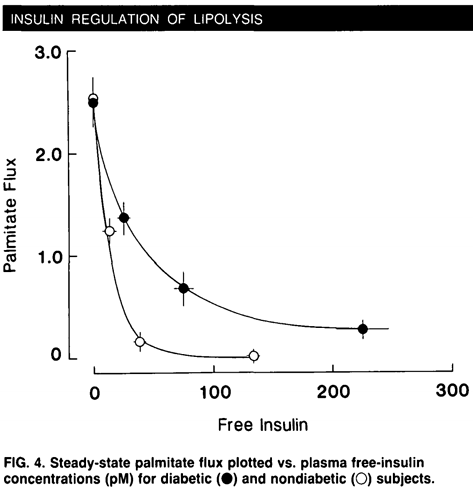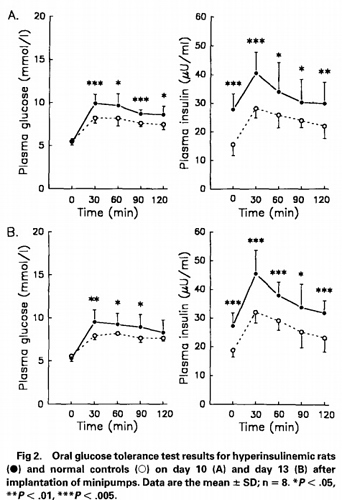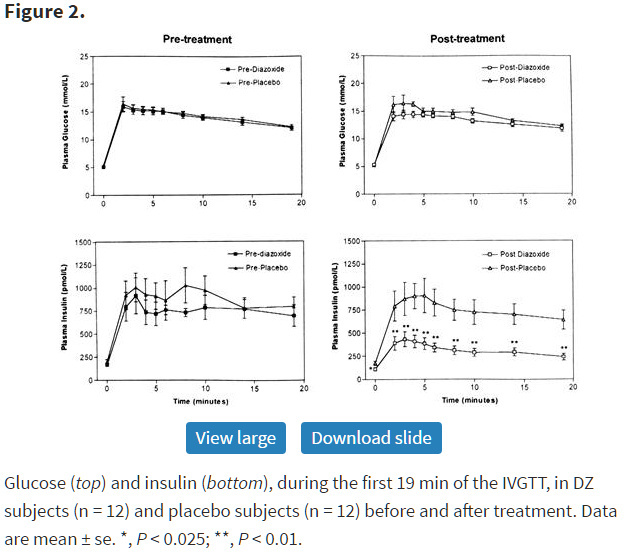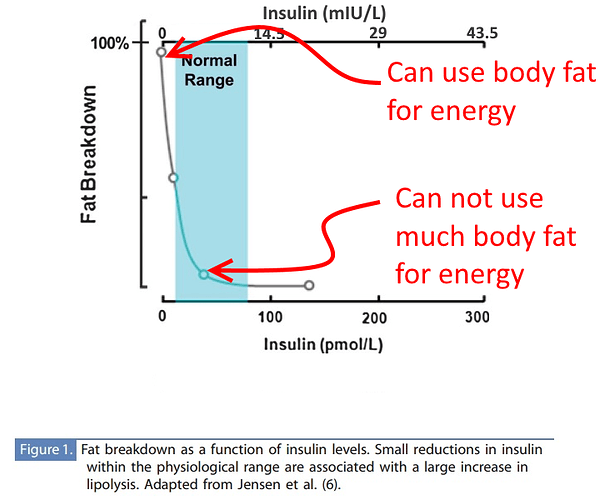So I want to collect studies that support (or refute) common hypotheses. We’ll start with this idea - that chronic exposure to high levels of insulin causes insulin resistance, and it’s corollary that exposure to lower levels decreases it.
Hypothesis: Insulin exposure causes insulin resistance
This study implanted micro pumps into rats that gave the rats extra insulin (controls got saline). After 10 days the insulin levels were naturally higher, the glucose levels however were not lower … indicating the rats had become insulin resistant.
from the study
Despite the persistent hyperinsulinemia originating from the insulin minipump, the rats maintained euglycemia after day 2 of the experiment (Fig 1). One could suspect that these rats may have a nullified blood glucose-lowering effect of hyperinsulinemia by mobilization of glucose-counterregulatory factors, including glucagon. However, based on our results, we believe these hyperinsulinemic rats developed insulin resistance very quickly.
This study exposed insulin resistant people to a chemical that inhibits insulin secretion (diazoxide) for 8 weeks and saw greater weight loss (than the placebo control) greater decrease in body fat and increase in fat free mass and less insulin in response to glucose (as you would expect) … yet no increase in glucose (per an intravenous glucose tolerance test).
This study does show that reducing insulin lowers body fat, but it also shows that people in the treatment arm were able to maintain glucose control with less insulin - effectively making them more insulin sensitive…
Yes, insulin receptors do run away and hide.
Continuous exposure to insulin causes a reduction in the number of receptors exposed on the cell surface by promoting internalization as well as degradation of hormone-occupied receptors (6). The insulin receptor is a tyrosine kinase that activates itself and then transmits its stimulatory message by promoting the phosphorylation of selected tyrosines on the receptor and on postreceptor partner molecules such as insulin receptor substrate family members IRS-1 and IRS-2 in the family of insulin receptor substrates. With continuous exposure to insulin, the receptor’s kinase activity is diminished, probably because of combined effects of phosphorylation of serine residues on the receptor, dephosphorylation of tyrosines by the action of phosphatases, and the binding of inhibitory molecules (41–45)
Many other references in full paper. Full title: “Insulin Resistance and Hyperinsulinemia Is hyperinsulinemia the cart or the horse?”
Do you know if Diazoxide is being used as a weight loss or diabetes medication? It sounds like it might have potential. This vicious cycle of insulin-makes-you-fat and obesity-makes-you-have-higher-insulin is enough to drive one crazy.
A the beginning of this podcast, you mentioned an insulin greater than 14 prevents weight loss. Do you have any links to share with more information on that?
I am wondering if anyone has done tests on insulin levels during an extended fast. How long does it take for insulin to reduce, and is the timeframe of that related to how high the person’s A1C is, and how insulin resistant they are?
I have so many questions, coming from frustration, about how long it will take to get permanent effects (especially reversal of diabetes and weight loss) from fasting/insulin lowering. If it were possible to get insulin tested daily during a 5-day fast, for instance, would that be worth doing, just to verify insulin does go down with fasting and to see how long it takes to get below 14?
I really wish someone could come up with that much sought-after home insulin test!
The study that identified insulin inhibition of lipolysis was https://www.ncbi.nlm.nih.gov/pubmed/2573554
They charted the difference between lipolysis inhibition for insulin dependent diabetics and non-diabetics … I assume that obese people with insulin resistant adipose tissue (but not specifically insulin dependent) have a similar curve to the insulin dependent diabetcs as they have both high insulin and overflow of NEFA.

The important thing is for people who have insulin sensitive adipose it doesn’t take much insulin to completely inhibit the release of energy from body fat. I mapped pMol/l to mIU/L (top X axis)
Insulin levels



